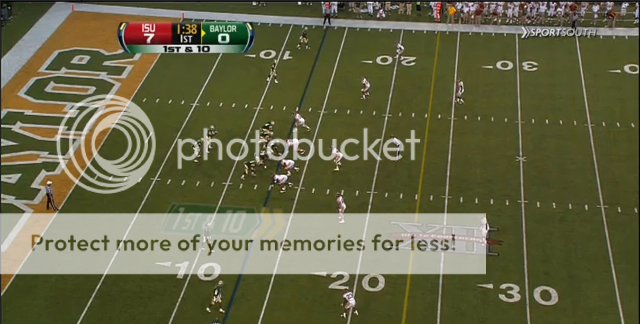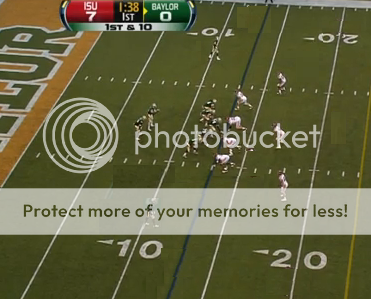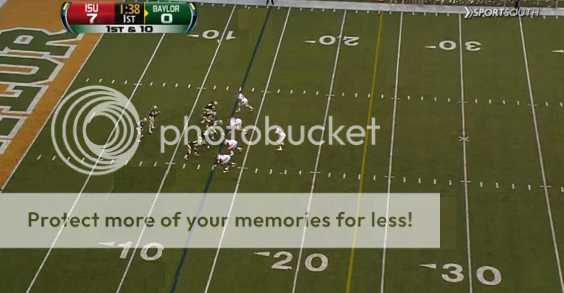ISU runs bubble screens to help open up the inside run and so does Baylor. With ISU keeping 2 safeties deep last year the bubble+run combo left your D in a no win scenario. I am posting this breakdown I posted on a BU message board not as smack but as a record of how what happened happened. I think ISU will have a different strategy this year FWIW.
Every year we get the exact same question asked ad nauseum on this board.
"Why do we run the bubble screen?"
"That bubble screen never goes for a TD"
and so on and so forth.
Here is why we do it.
First let's start with our basic 4 wide formation. This picture that I will be using is from what became a run of over 20 yards against ISU.

Now look at the following things in this photo-
1- ISU is petrified of giving Sampson, Wright, Reese, and Williams single coverage. They had seen the film on RG3 torching TCU, Rice, and KSU and felt they didn't have the athletes to run with us. It is evident by how far back their safeties (#22 Ter'ran Benton and #10 Washington) are lined up. They are lined up on the 25 and 27 yard lines- over 10 yards away from the ball. They will not be in any position to offer immediate help near the line of scrimmage.
2- Their LB #20 Jake Knott and nickel defender #24 Durrell Givens are lined up well inside of our slot WRs. Middle LB AJ Klein is right across from our interior OL.
3- The corners are aligned typically here opposite the Wideouts. They won't be a big concern in the run game here.
So we have 5 blockers on the offensive line and 2 slot WR and they have 7 guys who could be a factor in immediate run support with their 4 DL, 2 LBs, and nickel back Givens. Everyone else is too far away.
Picture 2 here is where I photoshopped out the players who would be irrelevant on an inside run play based on how the teams lined up.
- Our 2 outside WRs
- Their 2 CBs across from them
- Their 2 deep safeties

Looking at it there is no real way you can expect Kendall Wright or Tevin Reese to push LB Jake Knott around. Best we could do is crack down on them and hope to bounce the play outside but then the CB's and Safeties would usually react and stop us more often than not if we have to bounce outside a lot.
The fact is we are outnumbered 7 defenders to 5 blockers when you consider how ineffective the slots would be in pushing the defenders inside them around. We could make a play here or there but not with the kind of consistency we desire. We can do better than that.
So what do we do? We make the defense adjust to us. We threaten them with the following:

We threaten them with watching us complete the mother of all easy passes to our slots or outside WR's with the other one blocking the CB. This leaves the fast and elusive offensive player in a one on one situation against the safety who is lined up far away. Not what a D wants to see. Even if the safety makes the play it's 5-6 easy yards and it makes the rest of the D tire out running from inside the hashes. If the safety doesn't make the play it becomes big.
So if they widen out like so:

We now have 5 blockers on 5 defenders inside and will run them over all day long.

That is exactly how we did it. Here is how the play turned out:

In frame 1 we see that the 2 guys lined up initially inside the slot WRs are halfway to the numbers as Ganaway gets the carry. That is roughly 10 yards or so from the center of the field. We also see the 2 deep safeties are 15 yards away and largely irrelevant.
Frame 2 shows just how bad this hurts the D:
- The 2 slot defenders aren't even inside the hash marks before Ganaway is 3 yards upfield.
The bubble screen may be a frustrating play for some but it is consistently productive and sets us up for plays like this by forcing the D to account for it.
This simple adjustment helped Ganaway average over 8.5 yards per carry that night.
But what if they abandon the 2 deep safety alignment?
Then it opens things up in the pass game as the secondary players either have to go to a man coverage or cover 3 variation that isn't as good against the pass.

